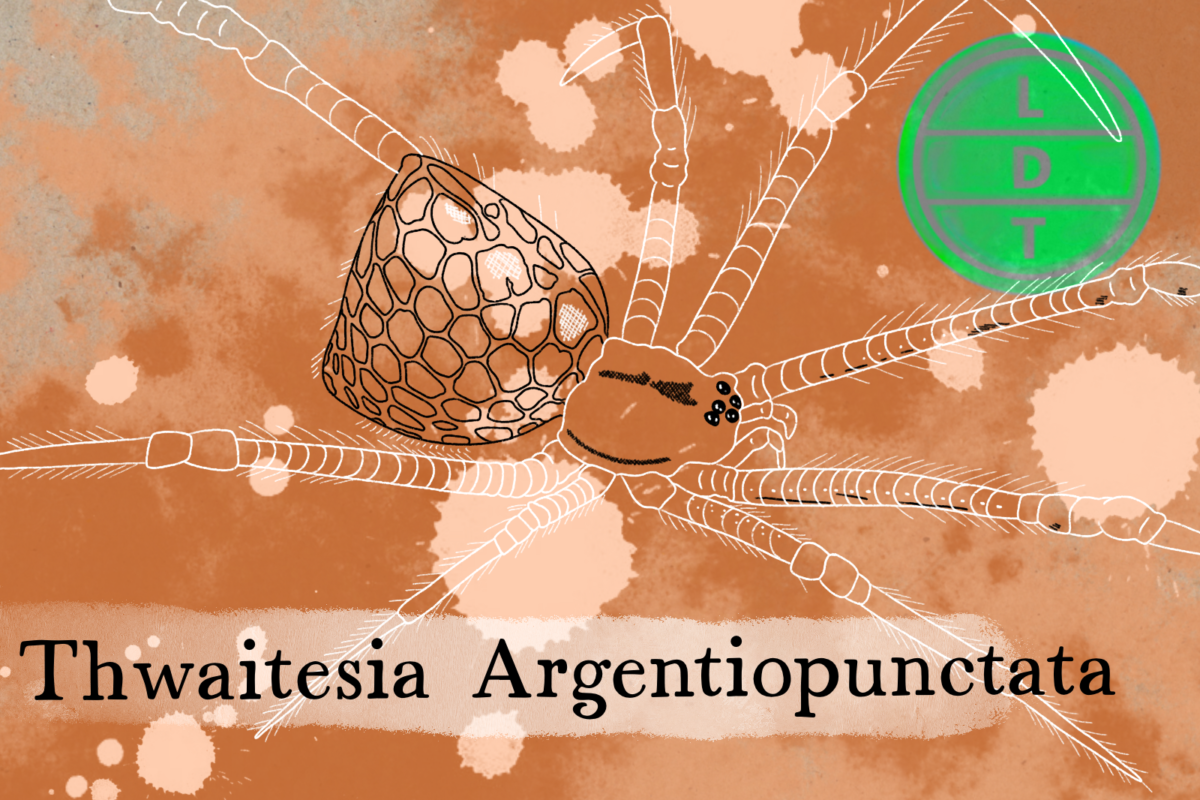“…and today we’re talking about the lurker in the cathedral, the stained aranea. But more on that later.”
In the forests of Australia, the glistening dew of a rain-kissed leaf might be a little more than just a water droplet. The mirror spider takes what would be waste to another spider and turns it into a beautiful mosaic of genius camouflage. Taking a few notes out of the cephalopod’s declassified wild survival guide, this little spider shines bright like a diamond, which is sometimes the way to survive here in Life, Death, and Taxonomy.
Description
- The mirror spider is a small spider with a big abdomen and a small thorax.
- They have proportionally longer legs that are a translucent cream color with brown joints.
- They have no other striking features that we will talk about at length by any means (this is a lie).
Measure Up
Welcome to the beloved Measure Up segment. The official listener’s favorite part of the show! The part of the show when we present the animal’s size and dimension in relatable terms through a quiz that’s fun for the whole family. It’s also the part of the show that’s introduced by you when you send in audio of yourself saying, singing, or chittering the words Measure Up into ldtaxonomy at gmail dot com. We don’t have a new Measure Up intro!
Female Length
- 4 mm (0.16 in)
- How many female spiders go into the diameter of an Oreo Cookie?
- Hint: Oreos were developed by the National Biscuit Company (Nabisco) in 1912. They were nearly direct copycats of the Hydrox, a cookie developed by Sunshine Biscuits in 1908. Hydrox was ultimately defeated by Nabisco after decades of rivalry. In 2015, Leaf brands, the new owners of Hydrox, brought the cookie back with a vengeance. Its marketing is steeped in Americana and Oreo shade. It’s made with cane sugar, no trans fats or corn syrup, and Hydrox is “proudly made in the U.S.A.”
- 11 spiders. 1.75 inches (44.45 mm)
Male Length
- 3 mm (0.12 in)
- How many deck of cards thicknesses go into a male mirror spider?
- Hint: Playing cards are thousands of years old and may date back to 9th century China. The French-suited 52-card deck might date back to the 1300s, when France made their own version of the German-suited cards.
- 6.35 spiders. A deck of cards may be as much as 19.05 millimeters thick.
Fast Facts
The mirror spider lives in Australia. It’s most commonly found in leaves, trees, and bushes.
They eat small insects that they catch in tangled webs. Unlike orb weavers that seem to weave particular patterns, mirror spiders and their cousins use a haphazard design structure and follow no set pattern. They may also use sticky lines that they attach to the ground to catch ants and ground insects.
The genus Theridiidae has 3,000 species and it’s one of the most common house arthropods in the world. Members of the family are sometimes called cobweb spiders, because they are likely responsible for the spooky tangled webs that decorate old houses and neglected corners.
Members of the family sometimes engage in kleptoparasitism. They will live on the webs of larger spiders and eat small prey and even the silk from host webs.
Mirror spiderlings are rarely observed and we don’t have an official description of them yet.
Major Fact: Stained Glass Bottoms Up
The spiders are covered with crystalline scales made out of guanine, a reflective protein that makes up DNA but is also a waste product. Which is where we get the word “guano” from.
This is usually excreted out as spider poop, but this spider excretes it out onto its abdomen, giving it it’s signature silvery appearance.
This ends up being pretty good camouflage, since it makes this tiny spider just look like a glistening rain or dew drop.
They can change the size of these scales depending on how threatened they feel.
Scales are huge whenever they go on Twitter.
Actually, large scales is the norm. It can contract the muscles around the scales and shrink them, effectively hiding the guanine and rapidly changing their color. This is a lot like how chromatophores work in cephalopods.
Australian zoologists are happy that this spider is helping to dispel the whole “Australia has the most dangerous everything” idea.
I’d say that central Africa and Alaska have the most dangerous everything.
Australian Geographic notes that the first person to describe mirror spiders was named William Joseph Rainbow. They also call that ironic, which shows that almost no one understands what irony is. If it was ironic, his name would’ve been William Joseph Monochrome or William Joseph Colorblind.
Ending: So stay beautiful, engorge your scales, and dazzle your enemies like the mirror spider here in LDT.

